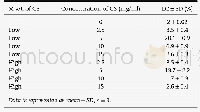《Table 3–The low molecular weight organic acid (LMWOA) concentrations (mg/L) under Pb stress.》
 提示:宽带有限、当前游客访问压缩模式
提示:宽带有限、当前游客访问压缩模式
本系列图表出处文件名:随高清版一同展现
《Woody species Rhus chinensis Mill. seedlings tolerance to Pb:Physiological and biochemical response》
As is to know,Pb is not essential element in plant metabolism(Zaier et al.,2010).In the present study,R.chinensis can grow normally under the lower Pb stress(25 to 50 mg/L Pb).However,the physiological processes were inhibited under the higher Pb stress(≥100 mg/L)and the visual damage(leaf dehydration and chlorosis)to the seedlings was observed.Malar et al.(2014b)also reported that under the heavy metal stress,biomass is a good indicator for plant growth.The similar phenomenon was observed in this study.For example,the concentration of Pb in roots was strongly negative correlation with the root biomass(Pearson r=-0.753,p<0.001,N=18).And these symptoms were also reported by Islam et al.(2007),Malar et al.(2014a)and Zhou et al.(2017)This phenomenon was due to the oxidative stress induced by Pb+(Mahdavian et al.,2016).In this study,the concentrations of H2O2,O2·-and MDA in leaves and roots were increased apparently compared to control,especially at the higher Pb concentration treatments(Appendix A Table S1)and showed the negative correlation with plant biomass.These results suggested that R.chinensis is tolerant to lower and moderate Pb concentrations in this growth medium.It also demonstrated that R.chinensis can actively react to the environmental changes via a series of physiological and biochemical responses.In the current study,most of the Pb was sequestered in the roots,which suggested that the high bioavailability of heavy metals could be limited once inside the plant.This is because the endodermis Casparian strips in the roots would block Pb transport(Zhou et al.,2016a,2017)Furthermore,endothelial cells of the root tissue also blocked Pb transport to aboveground parts(Kopittke et al.,2008;Sharma and Dubey,2005).Therefore,we speculated that the Pb accumulation in the roots is one of the Pb tolerance manifestations of R.chinensis seedlings.
| 图表编号 | XD0033524100 严禁用于非法目的 |
|---|---|
| 绘制时间 | 2019.04.15 |
| 作者 | Xiang Shi、Shufeng Wang、Dongxue Wang、Haijing Sun、Yitai Chen、Jianfeng Liu、Zeping Jiang |
| 绘制单位 | Research Institute of Subtropical Forestry,Key Laboratory of Tree Breeding of Zhejiang Province,Chinese Academy of Forestry、Research Institute of Forestry,Chinese Academy of Forestry、Research Institute of Subtropical Forestry,Key Laboratory of Tree Breedi |
| 更多格式 | 高清、无水印(增值服务) |
查看“Table 3–The low molecular weight organic acid (LMWOA) concentrations (mg/L) under Pb stress.”的人还看了
-

- Table 2–The effect of CS molecular weight and concentration on insulin LC%from PLGA MPs using double freezedrying techni
-

- Table 4–The effect of selected CS molecular weight and concentration on surface porosity%for plain PLGA MPs using double
-

- Table 3 The size, molecular weight, theoretical isoelectric point and hydrophobicity of the six unknown proteins





